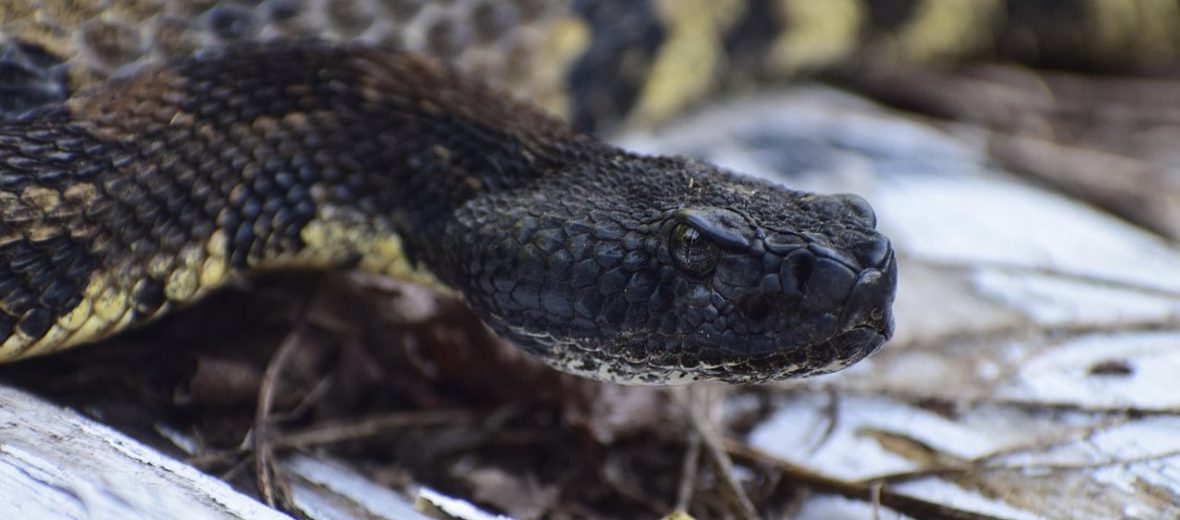
The timber rattlesnake can be found from southern Minnesota and even southern New Hampshire, down south to northern Florida and eastern Texas, in the United States. They prefer deciduous forests with rugged terrain, floodplains, wet pine flatwoods, swampy areas, lowland cane thickets, hydric hammocks, hardwood forests, and even cultivated areas. Gravid (pregnant) females like warmer, open, rocky ledges, while non-gravid females and males gravitate towards denser woodland habitats with a closed forest canopy. Even though they face the threats of habitat loss, vehicle strike (being hit with vehicles), hunting, trapping, ecosystem alterations, and human interference, these protected snakes are still listed as Least Concern by the IUCN. But their populations are decreasing.
First the Stats…
Scientific name: Crotalus horridus
Weight: Up to 3.3 lbs.
Length: Up to 5 feet
Lifespan: Up to 37 years
Now on to the Facts!
1.) Timber rattlesnakes are nearly entirely terrestrial (spend their lives on the ground). However, they can climb very well, if needed.
2.) Using chemical trails, these snakes will seek out the best locations to sit and wait for passing prey. When prey happens by, they will strike, bite, and release. Then track their prey down, via scent markings left behind by the victim.
3.) These vipers are cathemeral (active both day and night).
4.) Although typically solitary, during the winter months they will brumate (hibernation for reptiles) in alcoves with other species of snakes; like rat snakes and copperheads.
5.) Timber rattlers are listed among the most dangerous of North America’s venomous snakes. This is due, in part, to their high venom yield. But they tend to have a calm disposition and, unless startled, give you plenty of warning before striking.
But wait, there’s more on the timber rattlesnake!
6.) If threatened, these snakes will display the common tail rattling, huffing, puffing, and warning strikes.
7.) A group of snakes is called a bed, den, knot, nest, or pit.
Did you know…?
If bitten, the skin around the bite will swell and turn black. Their venom is a hemotoxin, which means it works to clot blood and destroy tissue (necrosis), as well as aid in prey digestion. Death is a potential, so a bite is medically significant and needs antivenom immediately to minimize damage and/or death.
8.) Timbers prey on mice, rats, gophers, voles, moles, small birds, frogs, and even other snakes.
9.) These vipers are preyed on by hawks, bobcats, coyotes, foxes, skunks, and king snakes.
10.) Just before birth, the gravid female will rest out in the open, in what is called a basking knoll. This way they soak up as much sunlight and warmth as possible before giving birth.
But wait, there’s still more on the timber rattlesnake!
11.) Like other pit vipers, these critters are polygynous (1 male mates with multiple females).
12.) Breeding season lasts from July – October.
13.) The female is receptive to breeding every 2 – 3 years.
14.) Females are viviparous (give live birth). She will produce eggs in her body that hatch internally and are born live. Like other vipers.
15.) Upon birth, the female will release up to 20 young snakelets. These baby snakes are precocial (self-sufficient at birth) and fully venomous. But they will stay with mom for up to 10 days, before dispersing to begin life on their own.
16.) Female timber rattle snakes can also hold onto sperm packets for up to 3 years!
Now a Short Timber Rattlesnake Video!
Be sure to share & comment below! Also, check out the Critter Science YouTube channel. Videos added frequently!
Want to suggest a critter for me to write about? Let me know here.
Think you know a lot about critters? Try your hand at these fun, free quizzes:
Photo credit: By Tanner Smida – Own work, CC BY-SA 4.0



